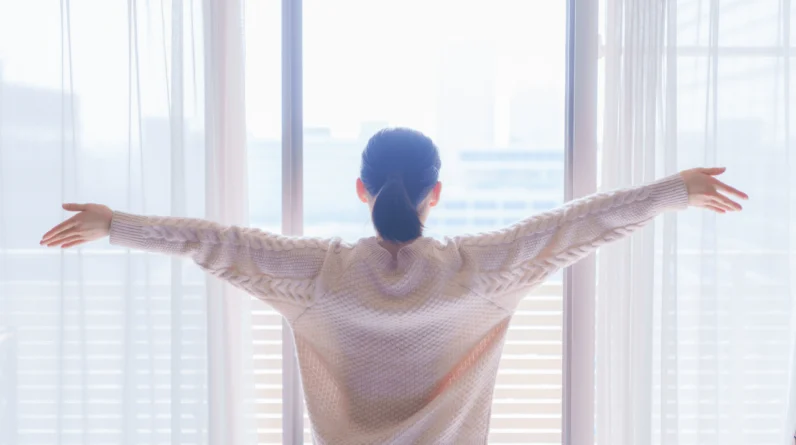
Have you ever tried an anxiety-reduction technique? It may be a good idea to try, especially if you answer, “Yes,” to any of these questions.
- Do you tend to be a worrier?
- Do you experience more anxiety than you’re comfortable handling?
- Have you ever had a period in your life where things seemed to be spiraling out of control?
- Where no matter what you tried, you ended up feeling highly anxious, discouraged, or angry?
If so, I completely understand.
Recently, I’ve been facing some obstacles and situations and the results I desire are taking longer than I want to manifest.
Though in general I feel thankful for the good in my life, some days I find myself thinking,
“Why isn’t this going the way I want?”
“Why can’t I stop dwelling on this?”
It can feel frustrating, for sure.
What You Dwell On Matters
What you dwell on matters.
I might also say what you dwell on tends to manifest more of the same. For example, I used to be quite the worrier, which is not helpful for the mind or the body.
Dwelling on worrisome thoughts can wreak havoc on the body, kicking the fight/flight or stress response into action time and time again.
Have you ever known someone who worried themselves sick? It happens all the time. In fact, doctors will tell you that high levels of stress, which can come from the mind, are leading factors for plenty of medical issues (As well as psychological.).
These days, I can more easily recognize when I am dwelling on negative or fearful and utilize practices I’ve learned to help change those thoughts into more positive ones. The result is that I feel less anxiety and more hope.
This helps my days to feel brighter and far more fulfilling than sitting around in anxiety and fear.
Anxiety-Reduction Daily Practices Can Help
I have adopted various daily practices that are helping me weather the storms that come my way.
Executing a daily practice or discipline influences my thought life, so when the tough obstacles and challenges come, my mind and attitude are more prepared to handle them.
If you tend to worry or feel quite a bit of anxiety, try some anxiety-reduction strategies to see what may help you. It’s wonderful if you can practice these daily, as it takes time to retrain the brain to swing from negative to positive.
The following is a list of various practices you can try out to see what helps you stress less and feel peace more.
- Give each of them a try for several days to a week and see if you feel improvement in your peace of mind.
- Some practices you may opt to do daily and others on an as-needed basis.
For example, I make meditation a daily practice. Anxiety-reduction breathwork like the 54321 method can also be used on an as-needed basis when you’re feeling high levels of anxiety.
7 Anxiety-Reduction Techniques to Try Right Now!
1. Take a brisk walk for 15 minutes.
Enjoying and offering gratitude for nature as you’re out there walking.
Exercise helps calm the mind, brings clarity, and peace.
2. Write down everything you’re grateful for.
Keep an ongoing “Gratitude List”.
This can help you change your focus from whatever it is you’re worrying about to more positive things in your life.
3. When you feel stuck dwelling on negative thoughts, sit down and write ten ideas about anything.
- Ten new ways to make money.
- Ten ways to help people.
- Ten positive affirmations.
- Ten people you can reach out to and let them know you care about them.
This practice can help your brain stop automatically going down the “worry grooves” and start to lay new tracks of better feeling thoughts.
4. Watch a motivational or inspirational video.
Utilize the motivational and inspiration videos on YouTube!
Check out different teachers and see who resonates with you.
You can make a favorite playlist and when you’re feeling stuck in “worry mode”, pull up that playlist and listen to it. I find that listening to encouraging podcasts or videos while walking helps me tremendously.
5. Play a mind game, like crossword puzzle, logic games or Sudoku.
The brain gets stimulated in a new way, which can help reduce some anxiety and also keep your mind sharp.
6. Pray or meditate.
Make daily prayer and meditation part of your life.
If you’re new to it, allot even five or ten minutes per day to quiet your mind and relax your body.
You’ll be surprised at how these daily practices will help you feel less anxiety over time. If you’re not sure how to pray or meditate, there are plenty of online articles and videos where seasoned teachers share with you various techniques.
7. Affirm wonderful things.
Get yourself an affirmation list and speak those affirmations daily.
If you’re dealing with a specific issue, Google that issue plus affirmations and draw from them.
For example, when I was dealing with extreme fear, I Googled “fear affirmations” and plenty of them popped up. They were quite helpful at reducing some anxiety.
Try one of our free daily affirmations now!
Bonus Anxiety-Reducing Technique!
Most of us struggle with anxiety from time to time.
Health experts state the chronic anxiety can cause a host of problems, including:
- insomnia
- depression
- burnout
- intestinal issues
- and more
In a world that doesn’t always feel secure, it’s easy to let anxiety get the best of you.
However, there are some easy, practical exercises that have been around for centuries that can be used as anxiety-reduction techniques in the moment.
Use this any time you feel anxiety begin to rise in your body. Or use it daily to help you feel safer and more secure. It can help you feel more grounded and in balance mind, body, and spirit.
This particular “hug exercise” I adapted from a technique learned from Dr. Peter Levine, who developed an alternative therapy known as somatic experiencing.
How to Do the Hug Exercise
Before you get started, I want you to think about your body as a container, as it truly is a vessel that houses not just your physical organs and systems, but your emotions too.
Keep in mind that if you’re feeling anxiety, your “system” isn’t feeling secure, so your aim is to cultivate safe feelings inside your container by giving yourself a gentle hug and “containing” any overwhelming emotions like anxiety.
You can stand or sit down. Put your right hand under your left arm, right there under your armpit.
- Take your left hand and place it on your right shoulder.
- Think of it as you giving yourself a gentle hug.
- Slowly inhale to the count of four and exhale to the count of seven.
- Note the sensations you feel inside your body at the moment.
- What do you feel?
You can continue to take slow, deep breaths or just breathe regularly. Stay in this position for as long as it takes until you feel a sense of calm or a release of that anxious energy. It may take 30 seconds or several minutes.
The key is to stay present with yourself (and all those sensations/emotions), while not judging them.
You notice, breathe, contain, relax, and give yourself a big dose of self-love, all the while bringing calmness to your nervous system.
It’s a win-win.
So, the next time you’re feeling anxious, give yourself a gentle squeeze.
On a side note, hugging someone else is also a great way to bring anxiety levels down. Choose someone you feel safe with, such as partner, friend, or family member, and embrace with a warm, gentle hug where you both relax into the hug.
Let them know ahead of time that this is what your goal is for the hug – that you’re experimenting with anxiety-reduction exercises.
In other words, ask them for their permission before you just go and hug them.
Anxiety-Reduction Techniques: Commit to the Discipline
Everyone has time for at least one anxiety-reduction technique each day.
Commit to the discipline, as it’s worth it! Think of it as an investment in your overall mental, emotional, and spiritual health.
A daily practice does not need to take hours each day. In fact, some days I only complete one or two of these activities and on occasion I don’t do anything. It depends on the day and what is going on.
The point is to become disciplined to take care of you mind, body, and soul and to do this, it takes some effort on your part. Don’t stress about a daily practice; just know that healthy rituals will help you along your life journey.
Editor’s note: This article was originally published Apr 26, 2022 and has been updated to improve reader experience.
Photo by Alexei Maridashvili on Unsplash







